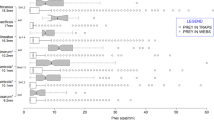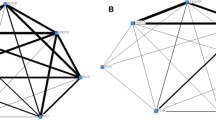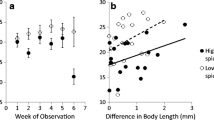Summary
In spiders, known as potentially cannibalistic, mutual tolerance is one important requirement for group life. Using the subsocial spiderStegodyphus lineatus which possibly resembles the ancestors of the social species, the effects of competition were investigated in the laboratory. When dispersal was prevented, spiderlings were capable of living in groups. The intensity of competition for food among spiders in groups was varied experimentally by varying group size or the relative size differences of individuals. Body mass and mortality were compared in the different experiments. Prey availability, the size of the spiders and initial body size differences among group members all influenced the survival probability and growth of the spiders. Spiders of equal size tolerated each other with a higher probability than spiders of different sizes. Feeding in groups was always disadvantagous even for the largest spiders.
Similar content being viewed by others
References
Bowden, K., 1991. The evolution of sociality in the spitting spider,Scytodes —fusca (Araneae, Scytodidae) — evidence from observations of intraspecific interactions.J. Zool. 223, 161–172.
Buskirk, R. E., 1981. Sociality in the Arachnida. In:Social Insects (Hermann, H. R., Ed.),Vol. 2. New York, Acad. Press, pp. 281–367.
Craig, C. L., 1991. Physical constraints on group foraging and social evolution — observations on web-spinning spiders.Fund. Ecol. 5, 649–654.
D'Andrea, M., 1987. Social behaviour in spiders (Arachnida, Araneae).Monitore zool. ital. (N. S.) Monogr. 3, pp. 1–152
Evans, T. A. and B. Y. Main, 1993. Attraction between social crab spiders — silk pheromons inDiaea socialis.Behav.Ecol. 4, 99–105.
Gundermann, J. J., A. Horel and B. Krafft, 1993. Experimental manipulations of social tendencies in the subsocial spiderCoelotes terrestris.Ins.Soc. 40, 219–229.
Jackson, R. R., 1979. Comparative studies ofDictyna andMallos (Araneae, Dictynidae). II. The relationship between courtship, mating, aggression and cannibalism in species with differing types of social organisation.Revue Arachnologique 2, 103–132.
Jackson, R. R., 1980. Comparative studies ofDictyna andMallos: V. Tolerance and resistance to starvation.Psyche 87, 211–220.
Krafft, B., 1979. Organisation et evolution des sociétés d'Araignées.J. Psychol. 1, 23–51.
Krafft, B., 1982. The significance and complexity of communication in spiders. In:Spider communication. (Witt, P. N. and Rovner, J. S., Ed.), Princeton, New Jersey, Princeton Univ. Press, pp. 15–66.
Krafft, B., A. Horel and J. M. Julita, 1986. Influence of food supply on the duration of the gregarious phase of a maternal-social spider,Coelotes terrestris (Araneae, Agelenidae).J. Arachnol. 14, 219–226.
Kraus, O. and M. Kraus, 1988. The genusStegodyphus (Arachnida, Araneae), bibling species, species groups, and parallel origin of social living.Verh. naturwiss. Ver. 30, 151–254.
Kraus, O. and M. Kraus, 1990. The genusStegodyphus systematics, biogeography, and sociality (Araneida, Eresidae).Acta Zool. Fennica 190, 223–228.
Kullmann, E. J., 1968. Soziale Phaenomene bei Spinnen.Ins. Soc. 15, 289–297.
Kullmann, E. J., 1972. Evolution of social behavior in spiders (Araneae; Eresidae and Theridiidae).Am.Zool. 12, 419–426.
Michener, C. D., 1969. Comparative social behavior of bees.Ann. Rev. Entomol. 14, 299–342.
Millot, J. and P. Bourgin, 1942. Sur la biologie desStegodyphus solitaires (Araneides, Eresides).Bull. Biol. Fr. Belg 137, 108–115.
Riechert, S. E., 1982. Spider interaction strategies: Communication vs. Coercion. In:Spider communication Mechanisms and Ecological Significance. (P. N. Witt and J. S. Rovner, Ed.), Princeton, New Jersey, Princeton Univ. Press, pp. 281–313.
Riechert, S. E., 1986. Spider fights as a test of evolutionary game theory.American Scientist 74, 604–610.
Rypstra, A. L., 1985. Aggregations of the spiderNephila clavipes (Araneae: Araneidae) in relation to food abundance.J.Arachnol. 13, 71–78.
Rypstra, A. L., 1986. High prey abundance and a reduction in cannibalism: the first step to sociality in spiders (Arachnida).J. Arachnol. 14, 193–200.
Rypstra, A. L., 1993. Prey size, social competition, and the development of reproductive division-of-labor in social spider groups.Am. Nat. 142, 868–880.
Schneider, J. M., 1992. Die Wurzeln des Soziallebens bei der subsozialen SpinneStegodyphus lineatus (Eresidae). Dissertation, Universität München.
Seibt, U. and W. Wickler, 1988. Bionomics and social structure of ‘Family Spiders’ of the genusStegodyphus, with special reference to the African speciesS. dumicola andS. mimosarum (Araneida, Eresidae).Verh. Naturwiss. Ver. Hamburg (NF) 30, 255–303.
Shear, W. A., 1970. The evolution of social phenomena in spiders.Bull. Brit. Arach. Soc. 1, 65–76.
Smith, D. R., 1983. Ecological costs and benefits of communal behavior in a presocial spider.Behav. Ecol. Sociobiol. 13, 107–114.
SPSS-X 1986. Statistical package for the social sciences. Release 3.1, Chicago, Illinois, SPSS inc.
Uetz, G. W., 1988. Goup foraging in colonial web-building spiders, evidence for risk-sensitivity.Behav. Ecol. Sociobiol. 22, 265–270.
Uetz, G. W. and M. A. Hodge, 1990. Influence of habitat and prey availability on spatial organisation and behaviour of colonial web-building spiders.Nat. Geogr. Res. 6, 22–44.
Vollrath, F. and D. Rohde-Arndt, 1983. Prey capture and feeding in the social spiderAnelosimus eximius.Z. Tierpsychol. 61, 334–340.
Ward, D. and Y. Lubin, 1992. Habitat selection and the life-history of a desert spider,Stegodyphus lineatus (Eresidae).J. Anim. Ecol. 62, 353–363.
Ward, P., 1986. Prey availability increases less quickly than nest size in the social spiderStegodyphus mimosarum.Behaviour 97, 213–225.
Ward, P. and M. M. Enders, 1985. Conflict and cooperation in the group feeding of the social spiderStegodyphus mimosarum.Behaviour 94, 167–183.
Wickler, W. and U. Seibt, 1993. Pedogenetic sociogenesis via the sibling-route and some consequences forStegodyphus spiders.Ethology 95, 1–18.
Wilson, E. O., 1971.The Insect Societies. Cambridge, Harvard Univ. Press.
Author information
Authors and Affiliations
Rights and permissions
About this article
Cite this article
Schneider, J.M. Survival and growth in groups of a subsocial spider (Stegodyphus lineatus). Ins. Soc 42, 237–248 (1995). https://doi.org/10.1007/BF01240418
Received:
Revised:
Accepted:
Issue Date:
DOI: https://doi.org/10.1007/BF01240418




